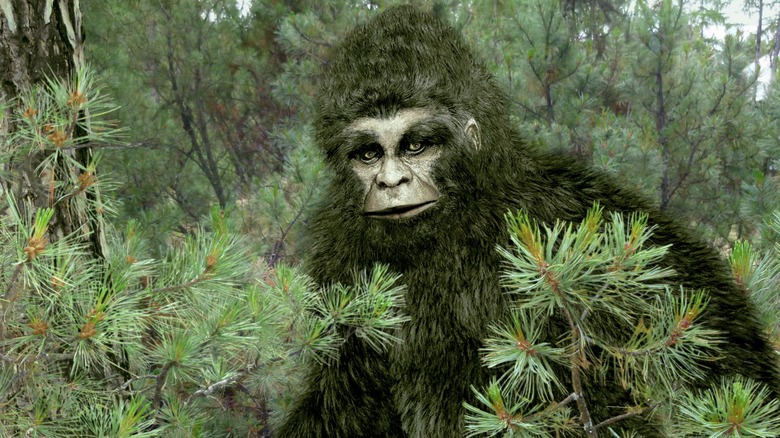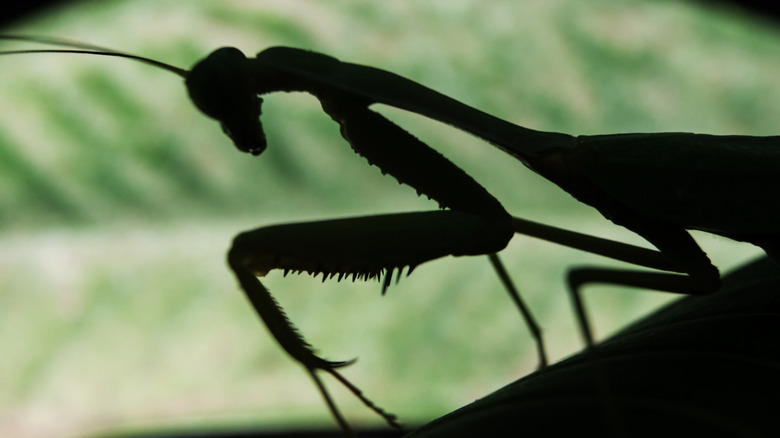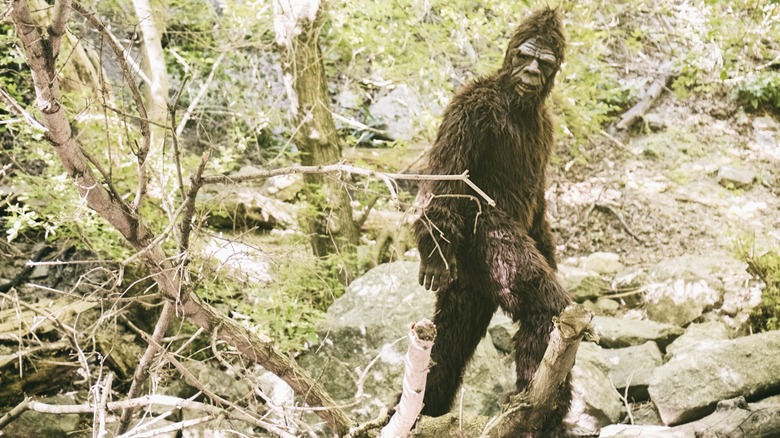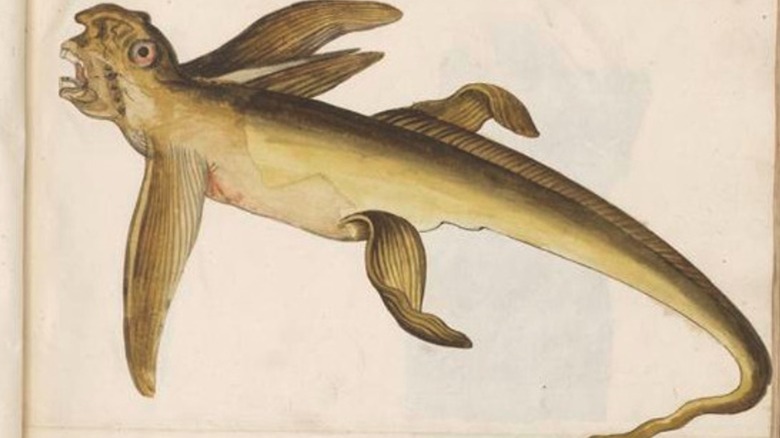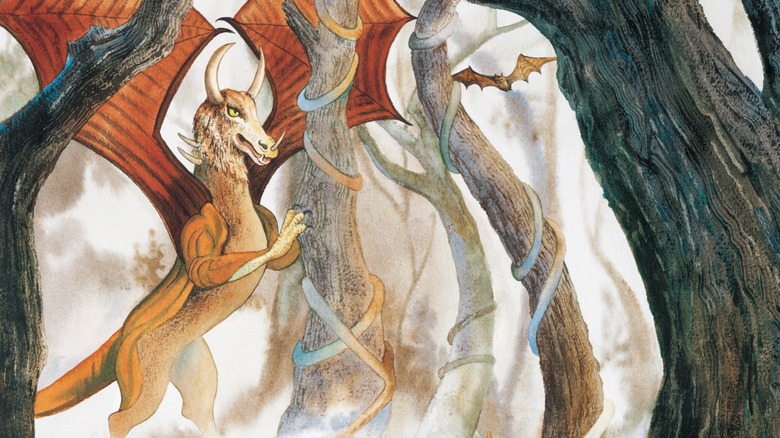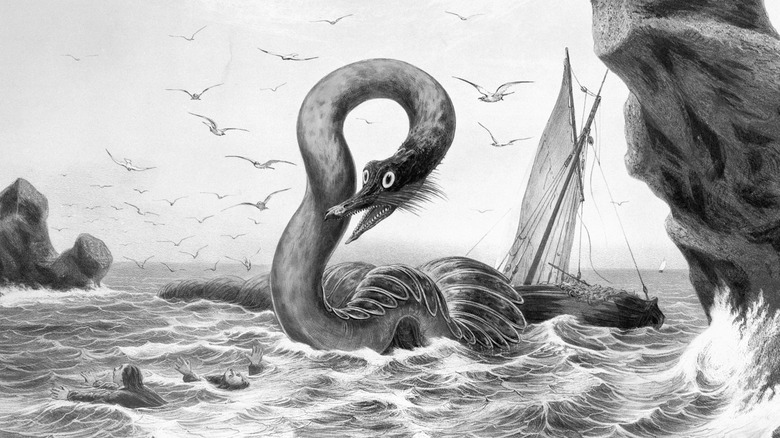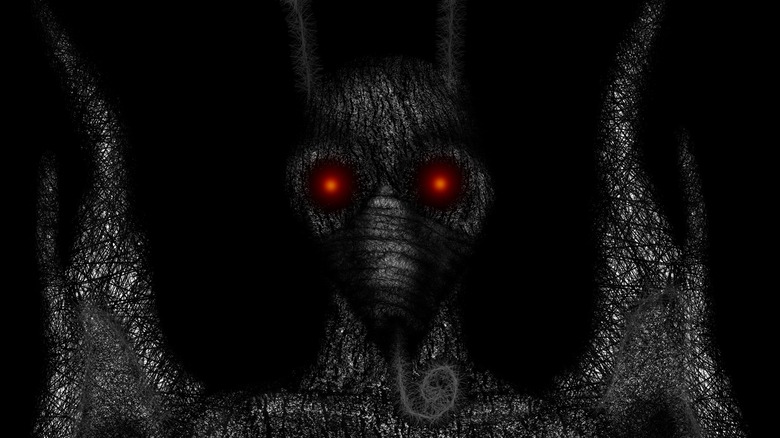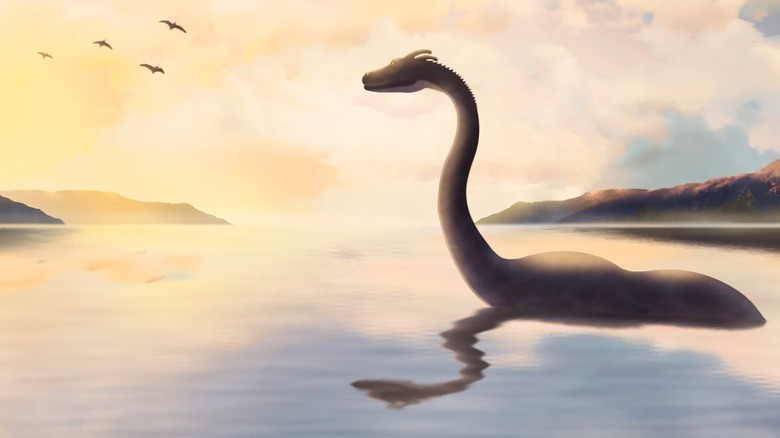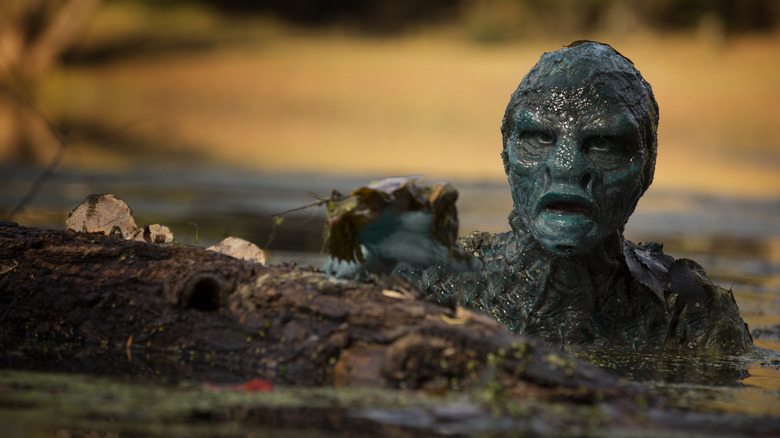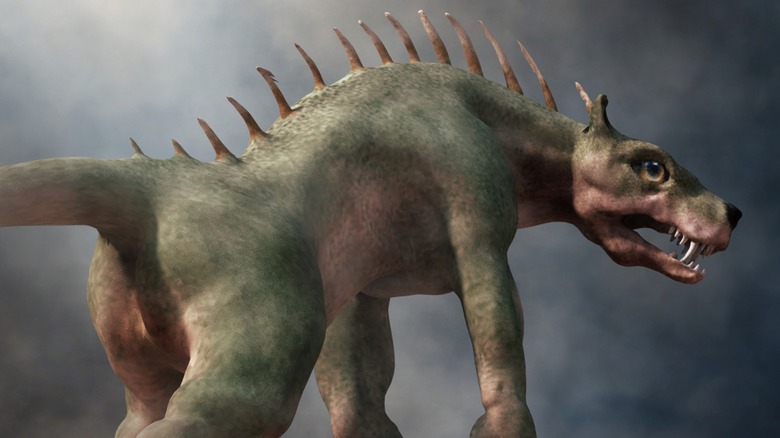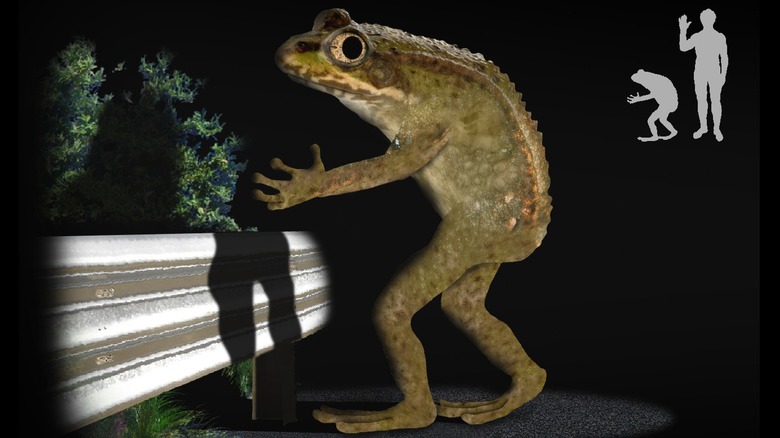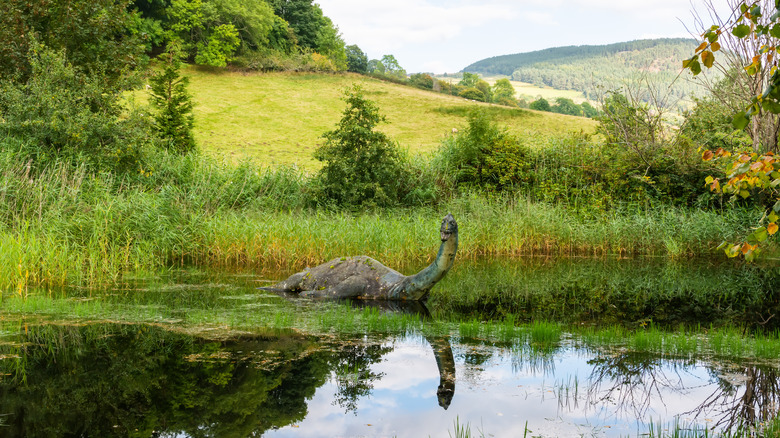Cryptids That Are Said To Roam The U.S.
It's a fact that mysterious creatures live among us. Scientists discover thousands of new animal species each year, many of which have gone undetected for ages, hiding in plain sight. While we now know that these animals are very real, some, like kangaroos, gorillas, and the giant squid, were once considered cryptids, or hidden creatures whose existence is unproven and heavily debated. Cryptids inhabit the realm where the imaginary meets real life, stalking the line dividing folklore and truth.
Oftentimes, they represent humanity's worst fears — like the unknown and unexplainable — and take beastly forms with sinister intent. You'll find cryptids skulking in deep water and lurking in dark, shadowy places throughout the world as legends brought to life, real animals yet to be explained by science, or known species that have simply ended up somewhere unusual. With its vast expanses of wild places, tremendous fusion of cultures, and tumultuous history, the United States is home to a wealth of such creatures.
While some, like the jackalope, have been declared obvious hoaxes with traceable origins, plenty of others persist in the form of alleged encounters, sightings, and blurry photographs, though concrete physical evidence — namely a body — has yet to be produced. From iconic beasts like Bigfoot to a plethora of prehistoric-looking lake monsters to relatively recent enigmas such as Mothman, here are a few cryptids that are said to roam the U.S.
Michigan Dogman
In the dense forests of northern Michigan, reports of a strange creature have been rolling in for over 130 years. It all started in 1887 when two lumberjacks claimed to have seen an unnaturally tall bipedal animal with the body of a man and the head of a dog while working in the woods. Sightings of the monstrous cryptid continued. Reports described it as having piercing blue or yellow eyes and an eerie, scream-like howl.
Dogman is said to appear cyclically every 10 years, emerging on years ending in seven. Some theorize that the creature protects sacred Indigenous American sites, as sightings often occur around such locations. Others attribute the canine creature to northern Michigan's native wolf population. But Joe Barger, a truck driver who experienced a recent Dogman encounter, suggested a more nefarious theory in his 2022 conversation with the YouTube channel "What Lurks Beneath."
In June of 2017, Barger was airing up the tires of his semi-truck in a remote Michigan forest near dusk when he heard strange sounds and saw a shadow in the woods. The two-legged shadow grew closer and proceeded to chase his truck, towering over 10 feet tall and peering easily into the window. He described the creature as having a massive, wolf-like head, 3-inch white fangs, black fur, and intelligent yellow eyes that were full of malice. Terrified, he shot the Dogman. Months later, he claims that federal agents showed up at his house, angry that he had killed their "asset."
Champ
A giant serpentine creature is said to live in Lake Champlain of the Adirondack Mountains in Vermont and New York. Sightings of the creature — locally nicknamed Champ or Champy – go back hundreds of years. Indigenous Iroquois and Abenaki people in the area warned early French settlers to avoid disturbing the large natural lake and angering the creature lurking in its waters, which they called Gitaskog and Bulwagga. Champ sightings continued throughout the 1800s and 1900s.
The creature is said to be anywhere from 8 to nearly 200 feet long and is commonly described as having an undulating silver snake-like body covered in scales and a long seahorse-like head containing many sharp teeth and sometimes horns. Other accounts describe it as being black, with white eyes, a red stripe on its neck, and a star-shaped marking on its head. Due to this variable but fish-like presentation, many historians attribute Champ sightings to the large garfish and sturgeon found in the lake.
Cryptozoologists, on the other hand, consider it to be a relict dinosaur living in the deep waters of the ancient freshwater reservoir. Champ sightings are still being reported, with hundreds of people claiming to have seen it and many snapping questionable photos or embarking on quests to find the creature. Luckily, this legendary lake dweller seems to be a benevolent cryptid, as there are no reports of it causing harm to people. Champ remains a beloved figure in the Adirondack region and is sometimes called "America's Loch Ness Monster."
Mantis Man
Not all cryptids are rooted in ancient lore. In fact, some are surprisingly modern. According to correspondence sent to paranormal researcher and author Lon Strickler and presented on his podcast "Phantoms & Monsters 'Personal Reports,'" several people near Hackettstown, New Jersey, separately reported seeing a giant 7-foot-tall praying mantis-like creature sneaking around in the forest on the shores of the Musconetcong River.
The various witnesses — who shared encounters from 2003 to 2012 — described it as being gray or brown, having large, slanted, bug-like eyes, strong grasshopper-like thighs, and a triangular head but a distinctively human body. Even stranger, the insect-like creature often appeared aware of them and conveyed a sense of surprise at being seen. After being discovered, it faded into its surroundings as though it had cloaking camouflage and was sometimes accompanied by a buzzing and tingling sensation in the air. Others described seeing strange red glowing eyes, hearing babbling chatter, and finding stiletto-like footprints on the banks of the river.
In several instances, witnesses cited the creatures' abilities to convey emotions and thoughts and appear see-through. Accounts of the New Jersey Mantis Man date back to 1987. Its appearance and peculiar supernatural traits have been compared to several other unexplained East Coast incidents — like the little green men of the Kelly-Hopkinsville encounter of Kentucky — and theories attempting to explain it describe it as an alien entity, an interdimensional being, a failed biological experiment, or a not-yet-refuted hoax.
Bigfoot
Bigfoot is perhaps the most well-known cryptid out there. It's described as a large, hairy, humanoid creature and is most commonly reported in the temperate forests of the northwestern United States and Canada. The concept of Bigfoot likely originated in Indigenous American lore (where one of its many names is Sasquatch), though it did not become known by its more mainstream name until 1958 when large 16-inch footprints were found near a logging site in northern California. Though the prints were later revealed to be hoaxed, the idea of Bigfoot captivated America.
In 1967, the famous Patterson-Gimlin Film — which featured allegedly real footage of a large ape-like creature walking along a river bank in northern California — further elevated the creature's status in modern times. Bigfoot is said to be fairly benevolent, but will occasionally warn encroaching people to stay away with tree knocks, hurled rocks, whistles and vocal mimicry, or unearthly howls. It is also described as having a pungent, foul smell. Theories attempting to explain the creature are myriad.
Some consider it an undiscovered primate or surviving race of Neanderthals, while others believe it is a shapeshifting interdimensional being of extraterrestrial origin. The idea of a giant North American ape is widespread. Similar cryptids have been described throughout the U.S., including Arkansas' Fouke Monster, Florida's Skunk Ape, and Arizona's Mogollon Monster, just to name a few. Despite frequent reports and a slew of questionable photographic and video proof, no definitive evidence of any such creature yet exists.
Steller's sea ape
Sometimes, the "truth" behind a cryptid encounter is simply lost to time. Such is the case with the Steller's sea ape, which was described in the icy waters of what is now Alaska by the famous naturalist Georg Wilhelm Steller while he was exploring the North Pacific as part of his Great Northern Expedition in 1741. According to Steller's published account in "Journal of a Voyage with Bering," the Steller's sea ape was a massive 6-foot-long seagoing mammal with a dog-like head, rotund body, long whiskers, red and white "cow-colored" fur, and a shark-like tail fin.
What's more, Steller described it as being playful and swimming close to the ship. Given that he was a respected naturalist who had described many real species — like the Steller's jay and Steller's sea lion – most people were inclined to believe his report, though no real evidence for such a creature existed and none have been seen since. While it's certainly possible that the sea ape went extinct — like the Steller's sea cow, which was discovered on the same voyage — others aren't convinced that the creature ever lived.
Some have even speculated that it could have just been a joke that got out of hand. Historians have pointed out the similarities between the long-whiskered sea ape and Vitus Bering, the mustached Danish captain of Steller's ship with whom he had an adversarial relationship. After all, Steller named the creature Simnia marina danica, which is Latin for "the Danish sea ape."
Jersey Devil
The Jersey Devil, also called the Leeds Devil, is a winged creature that has supposedly been seen in New Jersey for over 275 years. It was first described in the state's remote, marshy Pine Barrens in the mid-1700s. There, in a small township called Leeds Point, several folk tales describe the birth of a deformed child who was cursed and later escaped into the forest. The creature was considered a scourge and its appearance foretold wars and droughts and caused disasters.
The Jersey Devil is said to be a nocturnal beast with a body somewhere between a horse and a kangaroo. It has a long face, a whiplike tail, bat wings, cloven hooves, and, of course, horns. It is known to issue eerie wails and screams in the night. Sightings quickly spread from New Jersey to surrounding states and several notable people — including Napoleon Bonaparte's brother, Joseph – claimed to have seen the creature or found unexplained hoofprints in the snow.
In the early 1900s, so many people feared the Jersey Devil that scientists were asked to explain it and there was even a movement to capture one and display it in a zoo. Though definitive proof of the creature still hasn't turned up, sightings in southern New Jersey continue. It's often seen on lonely stretches of road at night, occasionally attacking people and chasing cars. In 2015, a man encountered what he described as a flying llama near a golf course, meaning the cryptid could still be out there.
White River Monster
Many believe that a fearsome entity dwells beneath the surface of the White River near Newport, Arkansas. The White River Monster, also called Whitey, is said to be an up to 65-foot-long gray snake-like creature with crusty skin and a spiny back that is capable of issuing a blood-curdling roar. The mysterious serpent figures prominently in Indigenous Quapaw lore and has been seen for over 100 years. Whitey has long had a penchant for sinking boats and even allegedly overturned a Confederate ship during the American Civil War.
Sightings peaked in the mid-1900s, with many claiming that they had heard or seen the creature swimming in the river or found its tracks along the shore. Over the years, it was variously described as having a mermaid's tail, a monkey-like head, and a long horn. It typically appeared shortly after a ring of bubbles floated to the surface, briefly emerged like a thrashing horse, and then retreated below the water. It rarely showed its head.
Accounts were so numerous and compelling that hunting parties went out seeking the creature and Arkansas even designated a refuge for it in 1973, likely due more to the money tourists seeking Whitey brought to the area than to ensure the creature's welfare. While biologists concede that something was out there, they believe that sightings of the cryptid can be attributed to lost elephant seals, hooded seals, or — most likely — Florida manatees that swam up the Mississippi River and entered the White River.
Mothman
Second to Bigfoot, Mothman is undoubtedly the most famous cryptid in the U.S. First sighted flying overhead by gravediggers in Clendenin, West Virginia, on November 12, 1966, it was most famously encountered by two couples driving together on a dark stretch of State Route 62 three days later in Point Pleasant, West Virginia. According to the witnesses, the winged, bipedal creature had glowing red eyes and stood over 6 feet tall. It resembled a giant man with white moth wings and appeared to dislike light.
It ran clumsily, then rose straight up into the air. And, unlike your average insect, it was capable of chasing their car — at that point driving around 100 miles per hour — for a considerable distance. From 1966 to 1967, the creature was accused of stalking Point Pleasant at night, stealing dogs and even collapsing a local bridge and killing scores of people. Like the Jersey Devil, it was viewed as an ominous portent of doom and despair, though no satisfying explanation for its existence was ever put forth.
Some claim it could have been a sandhill crane, a sleep paralysis-like hallucination, an extraterrestrial being, or simply the work of an unusually dedicated hoaxer. Nonetheless, Mothman has since been sighted throughout West Virginia and even in Chicago in recent years. The winged, red-eyed cryptid became a media sensation, inspiring several books, a museum, an annual festival, and a 2002 movie starring Richard Gere. There is even a 12-foot statue in its likeness in Point Pleasant.
Sharlie
Like dark forests, deep, cold water also breeds terror. Sharlie, also called Slimy Slim and the Twilight Dragon of Payette Lake, is a lake monster said to dwell in McCall, Idaho's Big Payette Lake. Indigenous Americans who inhabited the area in summer had long feared the lake's too-calm glacial waters and claimed that an evil spirit dwelled in the deep. Then, in the 1920s, loggers working near the lake's shore spotted a massive serpentine creature swimming so rapidly that it churned the surface.
Later sightings described Sharlie as an over 35-foot-long dinosaur-like creature with a large head, camel humps, and skin that resembled a shell. Like the similar Loch Ness Monster of Scotland, Sharlie is known to stick its head above the water like a periscope and typically leaves a pronounced wake when swimming. McCall locals are proud of their lake creature — which luckily does not seem to be malevolent — and refer to Sharlie as a female.
Sightings have continued into the modern age and some believe they could be attributed to large, misidentified lake sturgeon or a weather phenomenon called a seiche, in which strong winds and a sudden change in atmospheric pressure cause large standing waves and unusual ripples on an enclosed body of water's surface.
Lizard Man
While most cryptids have some sort of historical basis, some are completely modern. Take the Lizard Man, a creature born in the 1980s. The Lizard Man was first sighted in the small town of Bishopville, South Carolina, by a teenage boy changing a tire late at night in June of 1988. During the process, he was accosted by a green, scaly creature with long dark talons and red eyes that stood 7 feet tall.
The ravenous bipedal reptile ran up out of the Scape Ore Swamp and attacked his car — then went on to attack and damage several more cars in the area that summer, leaving its giant three-toed footprints behind. Local police were called out to investigate the incidents and took plaster casts of the prints but ultimately came up with nothing, and reports of the creature soon decreased. While much less frequent, sightings around Scape Ore Swamp are still occasionally reported.
In 2015, a man claimed to have seen Lizard Man dart across the road and into the water. He described it as having a long alligator-like tail, scales, and a short nose, but noted that it walked on two legs. That same year, a woman reported seeing a reptilian creature running out of the swamp's thick woods. Some theorize that the original '80s Lizard Man was a costumed hoaxer, while later sightings could have been an escaped emu or ostrich — which both leave large three-toed tracks — or a feral monitor lizard.
Chupacabra
With most cryptids seemingly confined to lakes, rivers, swamps, and forests, the American deserts might seem like a relatively safe place to be. But, as it turns out, mysterious creatures dwell there, too. By far the most famous desert cryptid is the chupacabra. Though the legend of this vampiric creature originated in Puerto Rico in the late 1980s and 1990s, many also claim to have seen them in the American Southwest and Florida and they have since become part of the local lore in these regions, especially in the southwestern states.
About the size of a medium-sized dog, the chupacabra is a nocturnal beast with glowing red eyes. "Chupacabra" is Spanish for "goat-sucker," and, true to its name, it is said to drink the blood of sheep and cattle at night, leaving their mangled corpses behind. Accounts vary, with some having fur and some having scales, but most agree that the cryptid has a prominent spiny back and large fangs. It may walk on four legs or hop on two and look like a dog, alien, or spiky gray kangaroo, depending on who you ask.
Most biologists attribute U.S. sightings of the creature to hairless foxes, wolves, and coyotes suffering from mange, which, being sickly and unable to hunt their normal prey, may have resorted to feeding on livestock. As for the mutilated corpses allegedly sucked dry by feasting chupacabras, these likely deteriorated due to natural processes – perhaps accelerated by the heat of the desert.
Loveland Frogman
Not all cryptids are inherently threatening. Some, like the Loveland Frogman, are just plain weird. Starting in the mid-1950s, residents of Loveland, Ohio, started seeing mysterious 4-foot-tall bipedal frogs in the headlights of dark roads at night, hanging out on riversides, or leaping onto cars near bridges. In one notable encounter alongside the Little Miami River, several frogmen seemed to be entrenched in deep conversation with each other, and then one of the creatures shot sparks out of a wand that emitted the curious smell of almonds and alfalfa.
In the 1970s, several police officers reported similar creatures on the dark roads around Loveland. Finally, one of the officers shot a frogman and brought it in for examination. It turned out to be a tailless iguana, which seemed to settle the Frogman mystery — at least for a while. Sporadic sightings of the humanoid amphibian continued, with one notable appearance of Frogman occurring during an August 2016 game of Pokémon Go.
While searching for digital creatures in Loveland, Sam Jacobs and his girlfriend instead found a real-life humongous frog on the banks of Lake Isabella. Upon being discovered, it stood up on two legs and walked into the water. Luckily, Jacobs managed to take a few eerie, dim-lit photos and a video, which have brought the Loveland Frogman mystery back to life.
[Featured image by Tim Bertelink via Wikimedia Commons | Cropped and scaled | CC BY-SA 4.0]
Thunderbirds
Occurring in the lore of Indigenous American nations across the U.S., thunderbirds are massive vulture-like birds with white ruffs and impressive wingspans of up to 70 feet that are said to grace skies all across America. Much larger than any living bird — and, for reference, significantly bigger than both Pteranodons and Cessnas – they are believed to cause storms by beating thunder with their long wings and shooting lightning from their eyes or beaks. Thunderbirds are frequently carved into totem poles and are even featured in petroglyphs that are over 1,000 years old.
While they're typically viewed as powerful but benevolent mythological symbols, some people claim to have seen thunderbirds in modern times. They are sometimes said to snatch dogs, calves, and children, as famously occurred in Lawndale, Illinois, in July of 1977 when Ruth Lowe allegedly witnessed two giant birds with around 10-foot wingspans working in tandem in an attempt to carry off her 10-year-old son while he played in the backyard. Shockingly, one even succeeded in lifting the boy off the ground and carrying him 35 feet before abandoning the attempt and flying off.
Lowe's description of the large black birds with white ruffs and long bills that were slightly hooked at the end did closely match historic depictions of thunderbirds. Indeed, the area's Indigenous Cahokia people had long featured thunderbirds in their lore. Of course, the birds could also have been a living species, like turkey vultures or lost California condors, though these scavengers rarely attack living prey.
Altamaha-ha
Altamaha-ha, also called Altie or the "South's Loch Ness Monster," is an aquatic creature said to live in the small streams and marshes at the mouth of southeastern Georgia's Altamaha River, which empties into the Atlantic Ocean. The area's Indigenous Lower Muskogee Creek people have described a malevolent, bellowing sea creature in the river's waters for centuries — long before the land was settled by Europeans.
Altie is said to resemble a large greenish-gray sturgeon or giant eel with a pale underbelly but leap-swims like a dolphin, leaves a wake, and sometimes basks on the shore. It is between 30 and 70 feet long, has bulging eyes, front flippers but no back flippers, rough skin, a bony back, and a long crocodile-like snout with many sharp teeth. When disturbed, the creature allegedly hisses or roars.
People have been seeing Altie — and its smaller kin — pretty consistently since the first documented sighting in 1830 and some have even captured videos, though they remain inconclusive. Because the creature is sighted in various sizes, cryptozoologists believe there may be an entire population of the elusive aquatic cryptid – though compelling physical evidence of its existence has yet to surface.
